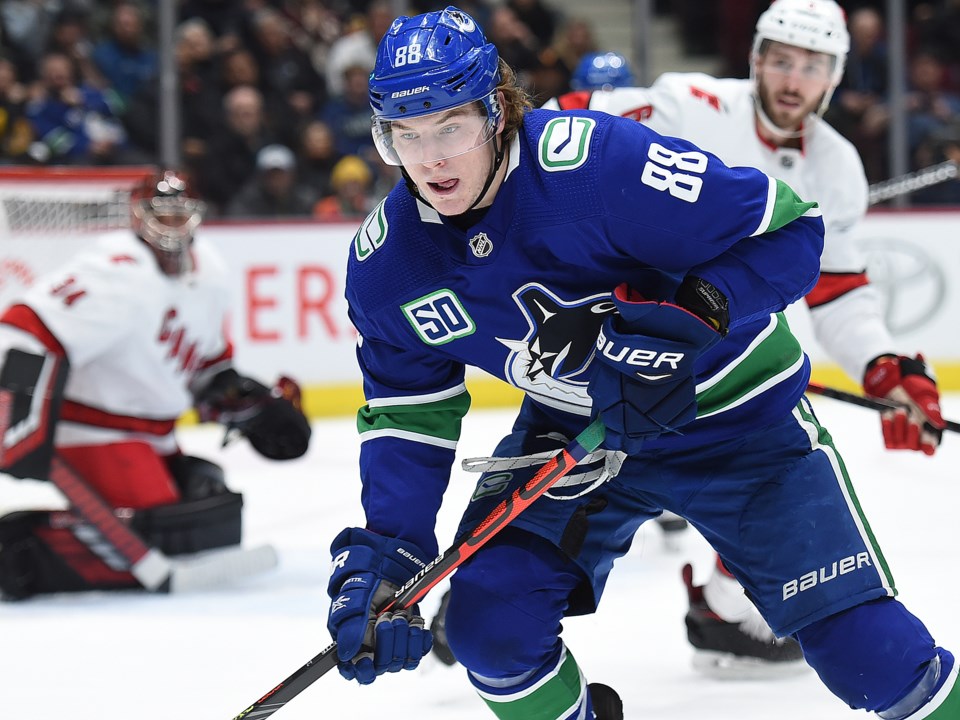The Canucks’ cap situation is like a room flooding with water, with only a little air left at the top left to breathe. General manager Jim Benning desperately needed to find a way to let a little water out of the room by finding some salary cap savings.
Fortunately, one of the Canucks’ key restricted free agents was even more restricted than most, giving the Canucks the opportunity to save a little money.
Adam Gaudette didn’t meet the requirements to become a “Group 2” restricted free agent. He would have needed to play three professional seasons, but his five games in 2017-18 don’t qualify as a season. Thus, Gaudette was a 10.2(c) free agent with next to no leverage. He was ineligible for an offer sheet or for arbitration, so could only negotiate with the Canucks.
There’s a lot of past-tense verbs in the previous paragraph because Gaudette is no longer a 10.2(c) free agent. The Canucks re-signed Gaudette to a one-year, $950,000 contract on Monday morning.
The pros and cons of this deal are simple: the pro for the Canucks is that they got Gaudette on a great contract for next season, paying him under a million dollars with the presumption that he’ll be the team’s third-line centre. That eases their cap burden and gives them a little more wiggle room as they negotiate with their other key restricted free agent, Jake Virtanen.
The con, however, is that they miss out on an opportunity to lock down Gaudette for longer on a cheap deal. If Gaudette has a great season, he’ll return to the negotiating table in a much stronger position to ask for more money. Gaudette will join Elias Pettersson, Quinn Hughes, and Thatcher Demko in what could be a very expensive RFA class for the Canucks next offseason.
Both sides, then, get something out of the deal. The Canucks get some cap savings next season when they badly need them, since they’ve been unable to trade away any of their expensive bottom-six contracts. Gaudette gets to bet on himself, trusting that he can take a big step forward next season and cash in when he has more leverage.
Is he likely to take a step forward next season?
What to expect from Adam Gaudette in the 2020-21 season
Somewhat lost in the fervour for some of the Canucks’ other young stars, Gaudette quietly had a strong sophomore season. Or not-so-quietly sometimes, given his .
Gaudette tallied 12 goals and 33 points in 59 games, providing some secondary scoring outside of the top-six. Where he had the biggest impact was on the power play, where he was essential to the second power play unit. When he was scratched during the playoffs, in fact, the second unit became completely discombobulated.
At 5-on-4, Gaudette was one of the most efficient point producers on the power play in the entire NHL. Among players with at least one hour at 5-on-4, Gaudette was third in points per 60 minutes, behind only Connor McDavid and Leon Draisaitl.
That’s pretty heady company for a third-line centre, but the power play has always been a specialty for Gaudette. When he won the Hobey Baker in his junior year at Northeastern University, he led the NCAA in power play scoring, with 27 of his 60 points coming with the man advantage.
Gaudette should still be the linchpin for the second power play unit next season — the Canucks certainly haven’t added anyone that would take his place — so expecting another dozen or so points on the power play is reasonable. It’s not crazy to think he might even get the occasional look on the first power play unit, whether due to injury or if Brock Boeser struggles to find the back of the net.
The bigger question for Gaudette is whether he can add new layers to his game.
At 5-on-5, Gaudette struggled to drive play and control puck possession, despite playing soft minutes. If Gaudette can take a step forward at 5-on-5, adding more strength to win puck battles and a little more explosiveness in his first two steps to get in on the forecheck more quickly, that could make a big difference for the Canucks.
More importantly, it would be great for Gaudette to start contributing on the other side of special teams: the penalty kill.
One of the big issues for the Canucks is their clear split between top-six and bottom-six, with primarily their bottom-six forwards killing penalties. When top-six forwards like Tanner Pearson and J.T. Miller have stepped in on the penalty kill, the results haven’t always been pretty, which has necessitated keeping both Brandon Sutter and Jay Beagle in the lineup, as well as turning to expensive players like Loui Eriksson.
If Gaudette can take on some penalty-killing duties, that would give Travis Green a little more maneuverability with his lineup decisions, while also making Gaudette more indispensable.
That will likely require a big improvement on faceoffs, which has been a struggle for Gaudette thus far in his career. Over the last two seasons, Gaudette has a 40.9% faceoff percentage, easily the worst on the team among those that regularly take faceoffs. Even Brock Boeser, a winger, has been better in the faceoff circle than Gaudette.
That’s a problem, because Green is loath to use a centre that can’t win faceoffs on the penalty kill, where the faceoff takes on more importance. It’s too bad Manny Malhotra left the Canucks to join the coaching staff of the Toronto Maple Leafs. Gaudette could use more of his tutelage.
Overall, the Canucks can be happy to get Gaudette signed for under a million dollars. Even if they regret it next year when it comes time to sign him again, at least that will mean that he’s had a great season, so any bitterness will be sugared over.




